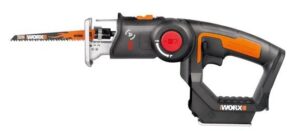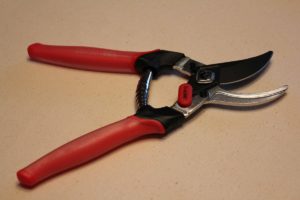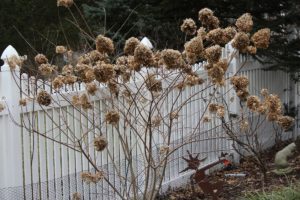Thinking about hydrangea pruning in late winter? I know we all get itchy fingers right about now, but take a deep breath and step back.
If your hydrangeas live in the milder parts of the U.S. and beyond, and the spirit moves you, you can consider pruning only your new wood blooming hydrangeas now.
Exactly which plants can you tackle now in those warm climates? The ones that are foolproof and will produce flowers on the stems they will grow this year.
First get your tools in order
But before you start your hydrangea pruning, however, get your tools in order. A good cleaning, oiling, and sharpening now will pay dividends and make your job much easier. Make sure you have a good pair of gloves, a tarp, a bypass pruner as shown in the photo, a lopper, disinfectant spray, and/or anti-bacterial wipes at the ready. I have also found a reciprocating saw comes in handy for those thick, sturdy stems.
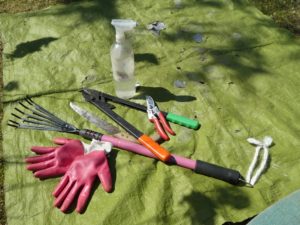
Assorted Hydrangea Pruning Tools
Fine Gardening ran an excellent article about Sharpening pruners which I recommend. It has a 10 minute video embedded in it with Lee Reich which you might find helpful.
Fit your pruner to your hands
The best advice about pruning tools I can give you comes from Corona Tools, a U.S. manufacturer of garden tools and so much more (www.coronatoolsusa.com/). Corona has been around for over 90 years and not only do they know tools, but they know how to FIT a tool to you.
Look at these very helpful graphics from Corona on how to make sure your pruner is the right fit for your hands.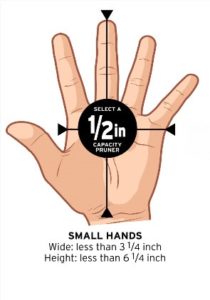 A small hand needs a pruner no higher than 6 inches.
A small hand needs a pruner no higher than 6 inches.
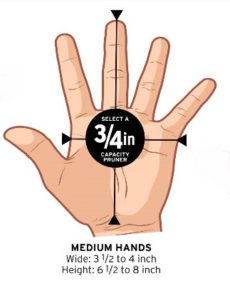
A medium hand can take a 7 inch pruner.
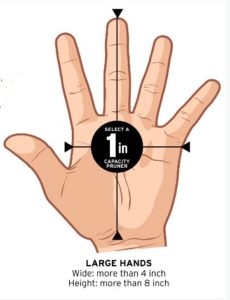 A large hand needs an 8 inch pruner or more.
A large hand needs an 8 inch pruner or more.
There’s nothing worse than working with a pruner that doesn’t fit your hand. And only you are the judge of that.
If you have some time to cruise the internet, you can find lots of videos on caring for your cutting tools. The key is to DO IT! Not just this once but throughout the season as sap, dirt, and debris will always clog your pruners and dull the cutting surface. That translates into jagged cuts, a potentially less healthy plant, and more work for you. You might need to invest in some diamond hones and other small items, but that investment will pay you great dividends.
Which hydrangeas can I cut now?
Back to your pruning job. Only go after woodland/smooth hydrangeas and panicle hydrangeas. Period. That’s because they flower on the growth they will put on in the next few months (new wood). So there is no danger of cutting off the flower buds. Exactly which hydrangeas are they?
All Hydrangea paniculatas like ‘Fire and Ice’, Fire Light®, ‘Limelight’, Pinky Winky®, and Little Quick Fire® are new wood bloomers. In short, they are hydrangeas that love the sun. Their flowers are cone- or football-shaped and can be white, green, and shades of pink (never blue), especially as they age. Some can be as small as 18” tall while others can be gigantic 8 footers.
The other new wood hydrangeas (arborescens) are woodland/smooth hydrangeas. They might be called ‘Annabelle,’ Incrediball, Haas’ Halo, etc. They also bloom on this year’s growth and can be found in semi-shaded and/or sunny sites. Their flowers are distinctively big round puffs of either green, white, or shades of pink (never blue).
How much to cut
How much do you cut back on your new wood flowering plants? Good question! I wouldn’t go further down than about 2 feet tall. You want to give the plant the ability to have strong stems to hold the deliciously large flowers, especially after rainfall. If you cut it to the ground or to its crown, as I have seen advised on various websites, you will wind up with weak stems. Those magnificent flowers hold water, which will weigh them down unless they have strong “old” stems to keep them erect. There is some research that shows cutting by about a third is the right amount for these plants.
How to prune a panicle hydrangea
Pruning your panicle hydrangea in late winter is easy. First, you can remove any stems that are dead, diseased, or damaged. Also look for stems that are growing inward or crossing/rubbing against other stems. Unmanaged, that will leave you with a damaged stem that can be a gateway for insects and disease later on.
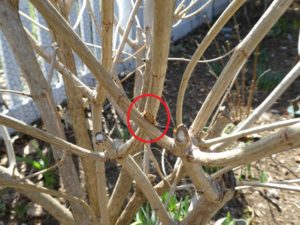
Prune hydrangea stems that cross which can bruise the plant
After that, you can simply deadhead your plant and let the rest go. But if you need to control growth to some extent, then the plant can be taken down by about one third, generally speaking. Unless you have a new plant that is barely 2 feet tall. Then the thing to do is just take off the tip, including any spent flowers.
But remember my earlier caution. If you live in a cold climate, leave the plant alone. There’s still some winter left and you want to allow for winter kill. Wait a few more weeks. Gardeners in zones 7 and warmer could take a chance and start now. Keep in mind there is always the possibility of late winter cold snaps which could knock your plants back. Before and after shots of ‘Limelight’ from my garden looked like this one spring.
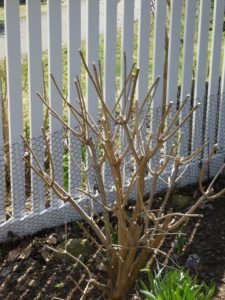
Hydrangea paniculata ‘Limelight’ after pruning
Pruning A Woodland Hydrangea
Start by removing the dead, diseased, and damaged wood. Do the same “opening up” task described for panicle hydrangeas and remove crossing and inward growing branches. You may even want to take out several stems at the ground level to reduce the overall size of your plant. My preference, however, is to dig out those ground level stems and start new plants somewhere else or give them away. They transplant wonderfully as long as you capture a good handful of roots.
Do Not Cut Your Woodland Hydrangeas Down To The Ground
No matter what you read on the internet, do NOT cut your woodland hydrangeas to the ground –EVER. When you do that, you encourage new stems that will not be strong enough to hold their later season flowers. Instead, leave several stems up at about 30 inches to help form a supportive framework for your plant.
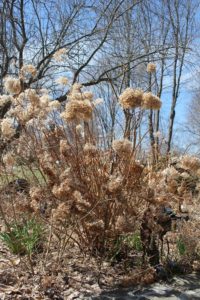
Woodland hydrangea before spring pruning
Pruning new wood hydrangeas is something you can master with a little time and attention. You’ll find them forgiving even if you make a mistake or two. Just be sure you prune them before they are too far along for this season or you’ll miss your window.
Be manic about hygiene
Make sure as you move from plant to plant that you disinfect your cutting tools. You don’t want to unintentionally move pathogens around your garden. Disinfecting is easy. You can use Lysol® spray or any number of disinfectant sprays on your tools to get into the crevices which can harbor the invisible offenders. Your other choice is to use a spray of rubbing/isopropyl alcohol from your home medicine cabinet with a spray bottle you can buy at the dollar store. Don’t forget to wipe down your gloves/hands.
What about pruning other hydrangeas
Don’t even think about cutting any of your other hydrangeas, no matter how ratty they may appear. Oak leaf hydrangeas, big leaf hydrangeas, climbing hydrangeas and mountain hydrangeas all bloom on old wood even if they are rebloomers. You must leave all of them alone. For them, you are in the HYDRANGEA DANGER ZONE™ (HDZ™), that time between August 1 and when you see buds. The HDZ™ is when those buds are most susceptible to all kinds of mayhem, but that shouldn’t include your pruning cuts. Their time will come soon enough, and you will be glad you let your plants get the last of their beauty sleep.
I cover pruning in detail with loads of photos in my book Success With Hydrangeas, A Gardener’s Guide.
Holding pattern for cold climate gardens
For cold climate gardens, I would hold off pruning hydrangeas for a little while more. We still have to deal with most of March, which can be harsh on your plants. You want to let Mother Nature take her best shot and allow for winter kill before you take the pruners to your plants. Plus, your footing needs to be safe and with sharp cutting tools, you want to be super careful. If your fingers are itchy to be out in the garden, take the time to get those cutting tools in shape. Clean, sharpen and oil them so they’re ready for the hard work ahead.
Upcoming talks
Why not plan to attend one of my upcoming talks? I have one live and one virtual hydrangea talk in March that may interest you. On March 12 I am at the New York Botanical Garden in the Bronx for a class on hydrangea pruning. That’s followed a few weeks later by a virtual NYBG class on March 25 on Weatherproof Hydrangeas.
In addition, I am continuing to book talks, both virtual and live (HOORAY!!!). If you are interested in having me speak to your group, just click HERE and you will be taken to the “Contact Me” page of my site to begin our dialogue. I cover lots of other topics besides hydrangeas, as you will see when you click on “Speaking Topics.” All my talks are 5-star rated, so you won’t be disappointed.
Newsletter changes on the Horizon
I am in the process of changing my email marketing service. The change should be invisible to you, but just in case things go off the rails, I wanted you to know. Fingers crossed things go smoothly (as I am told they will).
Thanks for reading.
6 Secrets for Stunning Hydrangea Flowers
Get my FREE mini-guide with 6 fool-proof tips showing how to grow hydrangeas that produce the most amazing flowers.
No spam - I promise!
